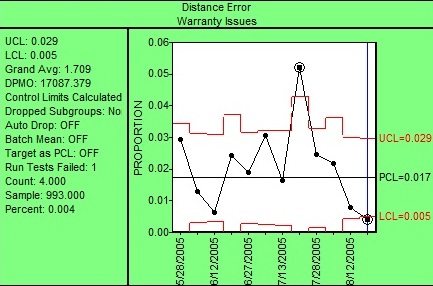Tools
Concepts
Interpretation & Calculations
Histograms, Process Capability
Applications
Key Success Factors for the Implementation of SPC
How to Study Process Capability
SPC to Improve Quality, Reduce Cost
Use Of SPC To Detect Process Manipulation
Interpreting an Attribute Chart

Each attribute control chart includes statistically determined upper and lower control limits, indicating the bounds of expected process behavior. The fluctuation of the points between the control limits is due to the variation that is intrinsic (built in) to the process. We say that this variation is due to "common causes" that influence the process. Any points outside the control limits can be attributed to a special cause implying a shift in the process. When a process is influenced by only common causes, then it is stable, and can be predicted. Thus, a key value of the control chart is to identify the occurrence of special causes, so that they can be removed, with a reduction in overall process variation. Then, the process can be further improved by either relocating the process to an optimal average level, or decreasing the variation due to common causes.
Attribute control charts are fairly simple to interpret: merely look for out of control points. The control limits may vary on the P chart and the U chart, based on the different sample sizes used for each plotted point. If the sample size does not vary by more than 10 or 15%, then you can use the average sample size on these charts to determine common control limits for all samples. This is often an option on your SPC software
If there are special causes, they must be understood. Brainstorm and conduct Designed Experiments to find those process elements that contribute to sporadic changes in process location. Remove the statistical bias of the out of control points by dropping them from the calculations of the process center line and its control limits. (This can be done automatically using the Auto Drop feature in our SPC software).
Remember that the variation within control limits is due to the inherent variation in sampling from the process. (Think of the Deming Red Bead experiment: the proportion of red beads never changed in the bucket, yet each sample had a varying count of red beads). The bottom line is: React first to special cause variation. Once the process is in statistical control, then work to reduce variation and improve the location of the process through fundamental changes to the system.
See also:
When to Use an Attribute Chart
Learn more about the SPC principles and tools for process improvement in Statistical Process Control Demystified (2011, McGraw-Hill) by Paul Keller, in his online SPC Concepts short course (only $39), or his online SPC certification course ($350) or online Green Belt certification course ($499).




